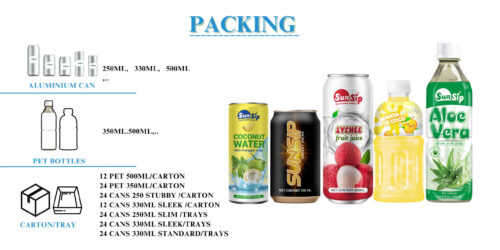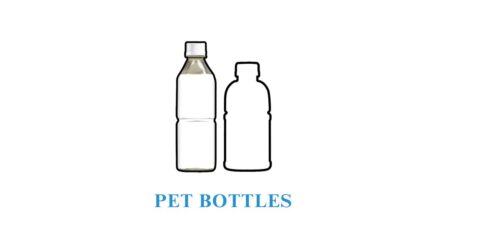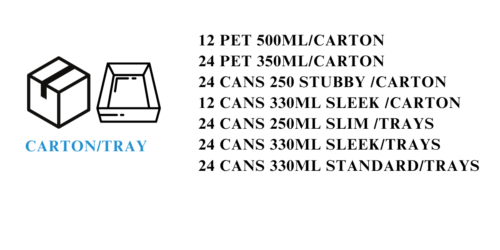In today’s fast-paced consumer market, packaging design plays a crucial role in attracting customers and enhancing brand identity. For Sunsip Beverages , a company dedicated to delivering high-quality and refreshing drinks, staying ahead of packaging trends is essential for maintaining market competitiveness, Sunsip is a prominent beverages manufacturer and exporter in Vietnam. Let’s explore the latest packaging trends that are dominating the industry and how Sunsip Beverages is embracing innovation.
 Overview of Sunsip Beverages Packaging Types
Overview of Sunsip Beverages Packaging Types
The beverage industry utilizes a variety of packaging types, each serving specific purposes in terms of convenience, sustainability, and branding. Below are the most common types of beverage packaging in Sunsip Beverages
To cater to the multifaceted needs of the market, sunsip beverages employs a diverse and comprehensive selection of packaging options. These encompass a variety of materials and forms, including Aluminum cans for a sleek and modern appeal, Pet bottles for convenience and durability, PP bottles for versatility, and Paper boxes for an eco-friendly and lightweight alternative. This strategic approach to packaging highlights Sunsip beverages commitment to accommodating a wide range of consumer preferences and ensuring its products are accessible and well-suited for different contexts and markets.
- Aluminum Cans

Aluminum cans are a popular choice for carbonated and energy drinks due to their ability to retain freshness and their high recyclability. They are lightweight, convenient, and provide excellent protection against light and oxygen, ensuring the quality of the beverage inside.
These aluminum cans are conventionally available in 250ml, 330ml, and 500ml volumes. Nevertheless, we maintain a flexible approach to cater to individual customer preferences. Widely utilized for packaging various beverages such as fruit juice, coconut water, carbonated drinks, and energy beverages, aluminum cans boast a shelf life of up to 24 months.
The packaging of these cans is typically organized into either cartons or trays, with a standard configuration of 24 cans per carton or tray, ensuring convenient handling and distribution.
Regarding product labeling, our practices usually fall within two main categories: cans featuring printed labels and cans with shrink labels, each serving distinct aesthetic and functional purposes.
- Plastic Bottles (PET Bottles)

Plastic bottles, particularly those made from polyethylene terephthalate (PET), are widely used due to their lightweight nature, durability, and cost-effectiveness. Many brands, including Sunsip Beverages , are transitioning to recycled PET (rPET) bottles to enhance sustainability efforts.These bottles emerge as an excellent solution for accommodating substantial liquid volumes. Notably, PET and PP bottles offer a shelf life of approximately 18 months, ensuring quality preservation over an extended period.
- Carton Packaging

Carton packaging, often made from a combination of paperboard, plastic, and aluminum, is commonly used for juices, milk-based drinks, and plant-based beverages. These cartons are lightweight, space-efficient, and often come with resealable caps for convenience. These cartons are engineered with a focus on durability and resilience, making them reliable for safeguarding the products within. They are often available in various sizes and can be tailored to specific needs. The construction of these cartons usually involves multiple layers, enhancing their protective capabilities and overall strength.
In addition to their robust build, these cartons exhibit superior quality finishing, adding a touch of professionalism to the packaging. This attention to detail extens to their aesthetic appeal, reinforcing the brand image and elevating the perceived value of the enclosed products.
Emerging Packaging Trends
- 1. Sustainable and Eco-Friendly Packaging
With growing environmental concerns, consumers are actively seeking brands that prioritize sustainability. Packaging made from recyclable, biodegradable, and compostable materials is gaining traction. Sunsip Beverages has adopted eco-friendly solutions, including plant-based bottles and minimal plastic usage, to align with the global shift toward sustainability.
- 2. Minimalist and Clean Aesthetic
Simplicity speaks volumes. Modern consumers appreciate sleek, uncluttered designs that highlight product quality. Clean typography, neutral color palettes, and simple graphics are becoming the new norm. Sunsip Beverages incorporates minimalist designs that focus on authenticity and transparency, ensuring customers feel confident in their beverage choices.
- 3. Smart and Interactive Packaging
Technology is revolutionizing packaging with features like QR codes, AR experiences, and smart labels. These elements provide consumers with instant access to product details, nutritional facts, and even engaging brand storytelling. Sunsip Beverages leverages smart packaging to create an immersive brand experience, connecting consumers to the origin and benefits of their favorite drinks.
- 4. Bold Colors and Unique Shapes
Standing out on the shelf is more critical than ever. Bright, bold colors and unconventional bottle shapes capture attention and make a lasting impression. Susip Beverages experiments with innovative packaging shapes and vibrant designs to differentiate itself from competitors and appeal to a diverse audience.
- 5. Personalized and Limited-Edition Packaging
Consumers love exclusivity. Brands are increasingly adopting personalized packaging and limited-edition designs to create a sense of uniqueness and urgency. Susip Beverages introduces seasonal packaging and customized labels, allowing customers to feel a personal connection to their favorite drinks.
Final Thoughts
The beverage industry is rapidly evolving, and packaging design is at the forefront of brand success. By embracing sustainable materials, minimalist aesthetics, smart technology, bold designs, and personalized experiences, Sunsip Beverages continues to lead the way in packaging innovation. As consumer preferences shift, staying adaptable and forward-thinking will be key to maintaining brand relevance and customer loyalty.

 Overview of
Overview of 

